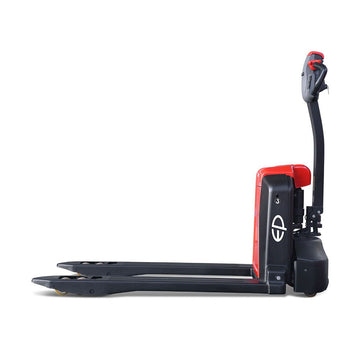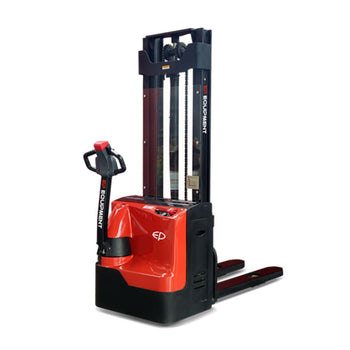In the fast-paced world of logistics, warehousing, and manufacturing, efficiency isn't just a buzzword – it's the backbone of success. Businesses constantly grapple with challenges like optimising workflows, managing inventory, ensuring worker safety, and keeping operational costs in check. The seamless movement of goods, from receiving docks to storage racks and onto outgoing shipments, is critical. Any bottleneck or inefficiency in this process can lead to costly delays, increased labor expenses, and potential injuries.
While forklifts often steal the spotlight in material handling, there's a simpler, often overlooked, yet incredibly powerful workhorse that forms the foundation of efficient operations: the pallet truck. These unassuming machines, also known as pallet jacks, are designed to lift and move pallets with ease, proving indispensable in scenarios where larger equipment can't go or isn't necessary. Far from being just a basic tool, a well-chosen pallet truck can significantly enhance productivity, streamline operations, and deliver a substantial return on investment for businesses of all sizes.
What Is a Pallet Truck?
At its core, a pallet truck is a wheeled trolley designed to lift and move pallets. It consists of a set of forks that slide under a pallet, a hydraulic or electric mechanism to lift the load slightly off the ground, and wheels for maneuvering. Despite their simple design, pallet trucks come in various forms to suit different operational needs, primarily categorised into manual and electric models.
Manual Pallet Trucks
The most common and fundamental type, the manual pallet truck, operates purely on human power. It features a pump handle that the operator cranks to engage a hydraulic system. This system raises the forks, lifting the pallet a few inches off the ground, allowing it to be moved manually by pulling or pushing the truck.
Common Features:
-
Simple Operation: Easy to learn and operate, requiring no special licensing (though training for safe use is always recommended).
-
Hydraulic Pump System: A robust system that allows for lifting even very heavy loads with relative ease.
-
Steering Handle: Provides directional control and doubles as the pump handle.
-
Nylon or Polyurethane Wheels: Designed for smooth movement across various floor surfaces, often with load wheels in the forks and steer wheels at the back.
-
Fork Length and Width: Standard lengths typically range from 36 to 48 inches to accommodate common pallet sizes, with varying widths.
-
Weight Capacity: Manual models can typically handle loads ranging from 2,500 lbs (around 1,130 kg) to 5,500 lbs (around 2,500 kg), with heavy-duty versions going even higher.
-
High Maneuverability: Their compact size allows them to navigate extremely tight aisles, corners, and congested spaces where larger equipment cannot.
Electric Pallet Trucks (Powered Pallet Jacks)
Electric pallet trucks take the effort out of material handling. Equipped with an electric motor and a battery, these machines assist with both lifting and moving pallets, significantly reducing operator fatigue, especially over longer distances or with heavier loads. They come in "walkie" models (where the operator walks behind or beside) and "ride-on" models (where the operator stands or sits on a platform).
Common Features:
-
Electric Motor: Powers both the lift mechanism and the drive wheels, eliminating manual pushing or pulling.
-
Battery Power: Typically lead-acid or lithium-ion batteries provide the energy, requiring regular charging.
-
Thumb Controls: Ergonomic controls on the handle allow for forward/reverse movement and fork lifting/lowering with minimal effort.
-
Variable Speed Control: Operators can adjust travel speed for precision handling or faster transport.
-
Higher Travel Speeds: Generally faster than manual pallet trucks, increasing efficiency for moving goods across larger facilities.
-
Increased Weight Capacity: While varying, many electric models can handle capacities similar to or greater than manual ones, often up to 6,000 lbs (around 2,700 kg) or more.
-
Reduced Operator Fatigue: The powered assist greatly reduces physical strain, allowing operators to work longer and more efficiently.
-
Enhanced Maneuverability (Powered Steering): While both are compact, electric models offer effortless steering and movement, especially when navigating tight turns or congested areas, as the power assists the directional changes.

Key Benefits for Warehouses
Integrating pallet trucks into your operations, whether manual or electric, offers a cascade of benefits that directly impact your bottom line and operational efficiency.
Time-Saving: Faster Movement of Goods
Time is money, and in a warehouse, every second counts. Pallet trucks significantly reduce the time it takes to move goods. Instead of manually carrying individual items or waiting for larger equipment, a single pallet truck can swiftly transport an entire loaded pallet. Electric models, with their powered drive, accelerate this process even further, making light work of long hauls within expansive facilities. This speed reduces loading and unloading times, expedites order fulfillment, and keeps your supply chain flowing smoothly.
Labor Reduction: One Person Can Move Heavy Loads
Imagine the effort and potential risk involved in moving a 2,000-pound pallet manually. It would require multiple individuals, if even possible, or specific lifting equipment. A pallet truck empowers a single operator to move such heavy loads safely and efficiently. This reduces the need for multiple workers on a single task, allowing your labor force to be reallocated to other value-added activities. It's about working smarter, not harder.
Space Optimisation: Helps Reorganise Stock and Aisles Efficiently
Warehouses are expensive per square foot, making efficient space utilisation paramount. Pallet trucks, especially their compact manual counterparts, are champions of space optimisation. Their smaller footprint compared to forklifts means they can operate effectively in narrower aisles and tighter spaces. This allows for denser storage configurations, maximising your warehouse's storage capacity. They make it easier to reorganize stock, pull inventory from less accessible areas, and maintain orderly aisles, contributing to a more efficient and safer working environment.
Versatility: Useful in Tight Spaces or Small Warehouses Where Forklifts Can't Go
One of the standout advantages of pallet trucks is their unparalleled versatility. They excel in environments where forklifts are too large, too heavy, or simply impractical. This includes:
-
Retail Backrooms: Moving stock from delivery to shelves without disrupting customers.
-
Small Warehouses and Storerooms: Navigating confined layouts.
-
Loading Docks: Efficiently moving pallets on and off trucks.
-
Manufacturing Production Lines: Supplying materials or removing finished goods.
-
Elevators and Mezzanines: Their lighter weight and smaller size often allow access to areas inaccessible to forklifts.
-
Last-Mile Delivery: Used by delivery drivers to quickly unload goods at customer sites.
Their ability to operate in these tight spots makes them an indispensable tool where larger machinery is simply not an option.
Safety Improvements: Reduces Strain on Workers, Lowers Injury Risk
Employee safety should always be a top priority. Manual lifting of heavy objects is a leading cause of workplace injuries, particularly musculoskeletal disorders (MSDs) affecting the back, shoulders, and knees. Pallet trucks drastically reduce the need for manual lifting and carrying, thereby minimising physical strain on workers. By providing a stable and controlled method for moving loads, they also significantly lower the risk of accidents caused by dropped items, improper lifting techniques, or trips and falls associated with carrying heavy objects. This creates a safer work environment, reducing workers' compensation claims and boosting overall employee well-being.
Cost vs. ROI
Investing in material handling equipment is a strategic decision. When it comes to pallet trucks, the financial argument is compelling, especially when compared to their larger counterparts like forklifts.
Low Upfront Cost Compared to Forklifts
This is perhaps one of the most attractive aspects of pallet trucks. A brand-new manual pallet truck can cost anywhere from a few hundred to just over a thousand pounds, while an electric walkie pallet truck might range from £2,000 to £6,000 or more, depending on features and capacity. In stark contrast, a new forklift can easily run into tens of thousands of pounds, with specialised models costing considerably more. This lower entry barrier makes pallet trucks an accessible investment for startups, small businesses, or large companies looking to equip multiple departments without breaking the bank.
Minimal Maintenance (Especially for Manual Models)
Manual pallet trucks are marvels of simplicity and durability. With fewer moving parts, they require remarkably little maintenance. Regular checks for wheel wear, occasional lubrication of pivot points, and ensuring the hydraulic fluid level is adequate are often all that's needed. This translates to minimal downtime and very low ongoing operational costs. Electric models require battery maintenance (proper charging, watering lead-acid batteries, and occasional inspection of electrical components), but overall, their maintenance needs are still significantly lower than those of an internal combustion or larger electric forklift.
Long Lifespan with Proper Use
Both manual and electric pallet trucks are built to last. With proper care and adherence to weight capacities, a manual pallet truck can easily provide 5 to 10 years of reliable service, and often even longer. Electric models, if their batteries are well-maintained and components are serviced as needed, can also offer many years of efficient operation. Their robust construction means they withstand the rigors of daily warehouse life, making them a durable asset that delivers consistent performance over time.
The combination of low upfront cost, minimal maintenance, and a long lifespan translates into an excellent Return on Investment (ROI). The efficiency gains, labor savings, and safety improvements quickly offset the initial purchase price, leading to tangible cost reductions and increased productivity year after year.

Use Cases Across Industries
The versatility of pallet trucks makes them invaluable across a wide spectrum of industries, adapting to diverse material handling needs.
Warehousing & Logistics
This is the natural habitat for pallet trucks. They are fundamental for:
-
Receiving and Shipping: Unloading incoming goods and preparing outgoing shipments.
-
Put-Away: Moving pallets from the receiving area to storage locations.
-
Order Picking: Transporting picked items to consolidation areas.
-
Cross-Docking: Efficiently moving goods directly from inbound to outbound trailers.
-
Inventory Management: Reorganising and consolidating stock within aisles.
Retail and Wholesale
From large superstores to independent shops, pallet trucks are crucial for managing stock behind the scenes.
-
Backroom Operations: Moving delivered merchandise from the receiving dock to storage or sales floor.
-
Shelf Replenishment: Transporting full pallets of goods closer to the retail aisles for stocking.
-
Seasonal Inventory: Managing fluctuating stock levels for seasonal promotions.
Food & Beverage
Strict hygiene standards and often heavy loads make pallet trucks ideal for this sector.
-
Cold Storage: Specialised models are available for refrigerated or freezer environments.
-
Distribution Centers: Moving beverages, packaged foods, and ingredients.
-
Restaurant Supply: Unloading deliveries and organising stockrooms.
-
Production Lines: Supplying raw materials and moving finished products to packaging or storage.
Manufacturing
In manufacturing facilities, efficient material flow is key to continuous production.
-
Raw Material Delivery: Bringing components and raw materials to the production line.
-
Work-in-Progress (WIP) Movement: Shifting partially assembled goods between workstations.
-
Finished Goods Transport: Moving completed products from the assembly line to packaging or shipping areas.
-
Tooling and Equipment Relocation: Moving heavy tools or machinery within the plant.
Choosing the Right Pallet Truck
Selecting the ideal pallet truck isn't a one-size-fits-all decision. Several critical factors should guide your choice to ensure you get a machine that perfectly matches your operational demands.
Factors to Consider:
-
Load Type and Weight Capacity:
-
What are you moving? Are they standard pallets, skids, or oversized loads?
-
How heavy are the loads? Always choose a pallet truck with a weight capacity that comfortably exceeds your heaviest expected load. Overloading can damage the equipment and pose significant safety risks.
-
Floor Surface and Environment:
-
Smooth Concrete? Uneven Asphalt? Carpet? Manual pallet trucks perform best on smooth, level concrete or warehouse floors. Uneven surfaces, bumps, or transitions can make pushing heavy loads difficult and increase wear on wheels.
-
Indoor or Outdoor Use? Most standard pallet trucks are designed for indoor use. If outdoor use is required, consider models with robust wheels and durable construction.
-
Temperature Extremes? For cold storage or freezer environments, specialised "cold storage" pallet trucks with appropriate lubricants and materials are necessary.
-
Wet or Corrosive Environments? Stainless steel or galvanised options are available for hygiene-sensitive areas (e.g., food processing) or corrosive conditions.
-
Frequency of Use and Travel Distance:
-
Occasional Use vs. Continuous Operation:
-
If you're moving a few pallets a day over short distances, a manual pallet truck is likely sufficient and most cost-effective.
-
If you're moving dozens or hundreds of pallets daily, across longer distances, or continuously throughout a shift, an electric pallet truck will be a game-changer. It reduces operator fatigue, speeds up operations, and maintains consistent performance.
-
Ramps or Inclines? Manual pallet trucks struggle significantly on inclines with heavy loads. Electric pallet trucks, with their powered drive, are much better suited for ramps and sloped surfaces.
Manual vs. Electric — Which is Right for You?
The core decision often boils down to this fundamental choice:
-
Choose Manual if:
-
Your budget is limited.
-
You have light to moderately heavy loads.
-
Your usage is occasional or intermittent (a few hours a day).
-
Your facility has smooth, level floors.
-
You operate in very confined spaces where even an electric model might be too wide.
-
You prioritise simplicity and minimal maintenance.
-
Choose Electric if:
-
You handle consistently heavy loads.
-
You require frequent, continuous use over full shifts.
-
You need to move goods over longer distances or up inclines.
-
You want to maximize productivity and minimise operator fatigue.
-
Your budget allows for a higher initial investment.
-
You have multiple operators who might share the equipment throughout the day.
Many businesses find that a combination of both manual and electric pallet trucks provides the most flexible and efficient solution, with manual units used for quick spot tasks and electric models handling primary material flow.
Why Your Business Should Get One Now
In today's competitive landscape, staying ahead means constantly looking for ways to optimise operations. Pallet trucks offer an immediate and tangible pathway to achieving this.
Easy to Implement
Unlike larger, complex machinery that might require significant infrastructure changes, specialised training, or dedicated charging stations, pallet trucks are remarkably easy to implement. Manual models are ready to go straight out of the box, and electric models typically only require a standard power outlet for charging. Their intuitive controls mean operators can be trained quickly, leading to minimal disruption to your existing workflows. This ease of integration allows businesses to start reaping the benefits almost immediately.
Scalable with Business Growth
As your business expands, so do your material handling needs. Pallet trucks are inherently scalable. Need to handle more volume? Simply add more pallet trucks. Their relatively low cost and compact footprint make it feasible to deploy multiple units across different areas or shifts. This scalability allows you to adapt your material handling capacity precisely to your evolving operational demands, ensuring you're always equipped to handle growth without significant capital expenditure on larger, less flexible equipment.
Reduces Downtime and Improves Workflows
Efficient material flow is the enemy of downtime. By enabling faster movement of goods, pallet trucks reduce bottlenecks at loading docks, production lines, and storage areas. When goods move smoothly, workers spend less time waiting for materials or clearing pathways, directly translating to improved workflow continuity. Electric pallet trucks, in particular, ensure consistent performance throughout a shift, preventing the slowdowns associated with manual fatigue. This leads to higher overall productivity, allowing your team to focus on their primary tasks rather than struggling with inefficient material transport.
Closing Thoughts
Often overshadowed by their larger, more visible counterparts, pallet trucks are the unsung heroes of efficient material handling. They are fundamental, versatile, and highly cost-effective tools that play a critical role in the smooth operation of countless businesses worldwide. From enhancing safety and maximizing space to reducing labor costs and improving overall workflow, the benefits of incorporating pallet trucks into your operations are undeniable.
Don't let the simplicity of a pallet truck deceive you; its impact on your productivity can be profound. If you're currently relying solely on manual lifting, or if your larger equipment struggles in tight spaces, it's time to assess your current material handling setup. Consider how a few strategically placed manual or electric pallet trucks could transform your operations, drive efficiency, and boost your bottom line. Investing in these essential tools isn't just a purchase; it's an investment in a more productive, safer, and streamlined future for your business.




